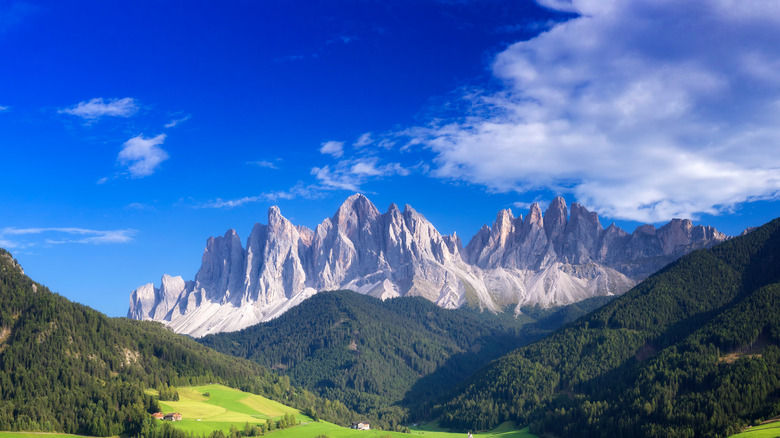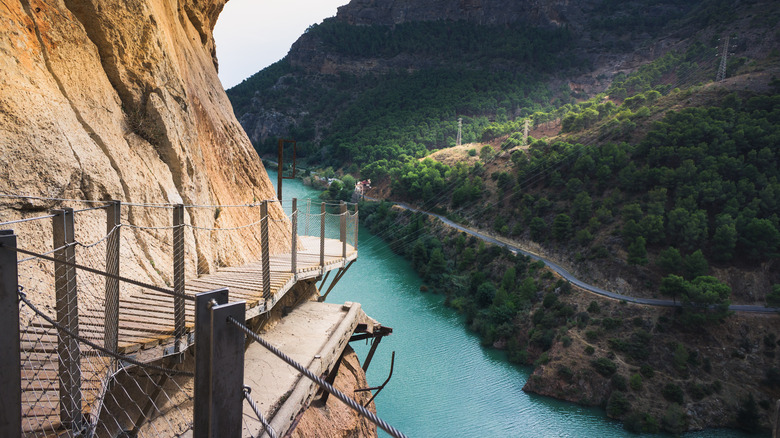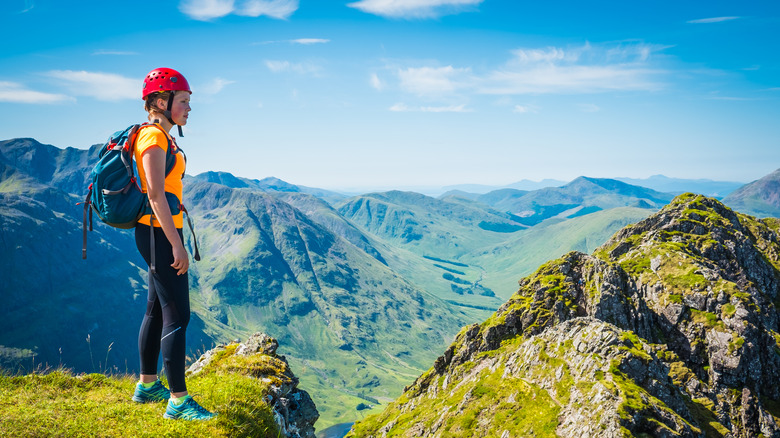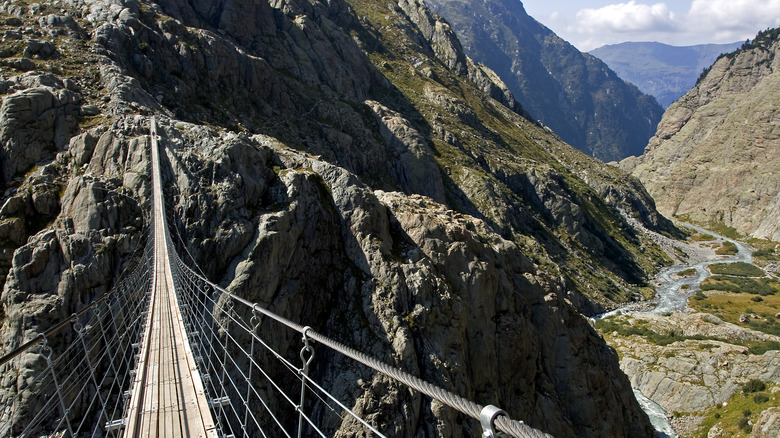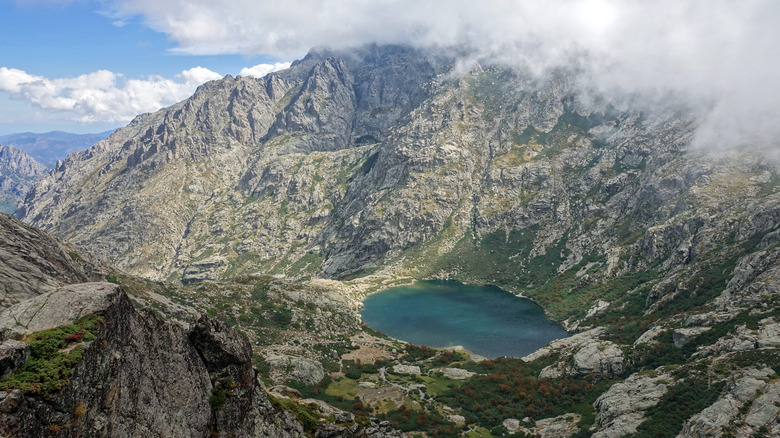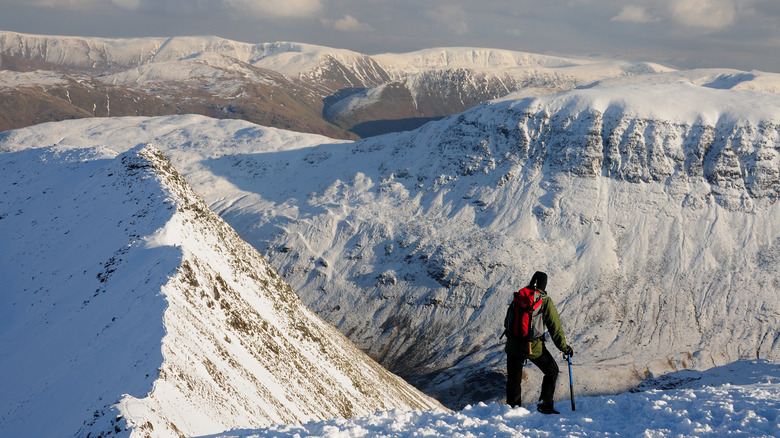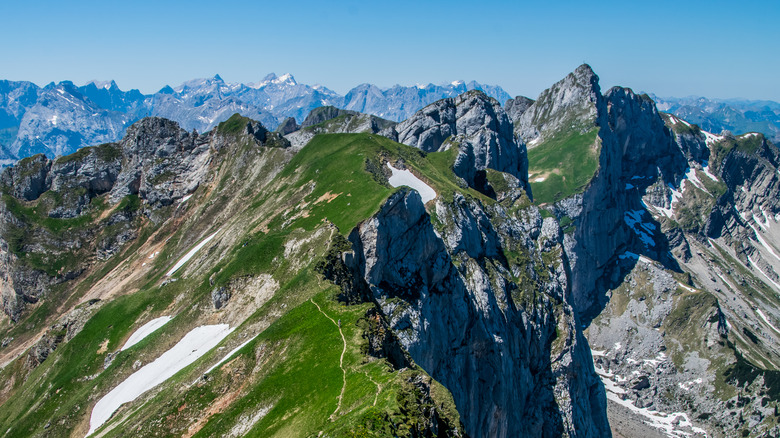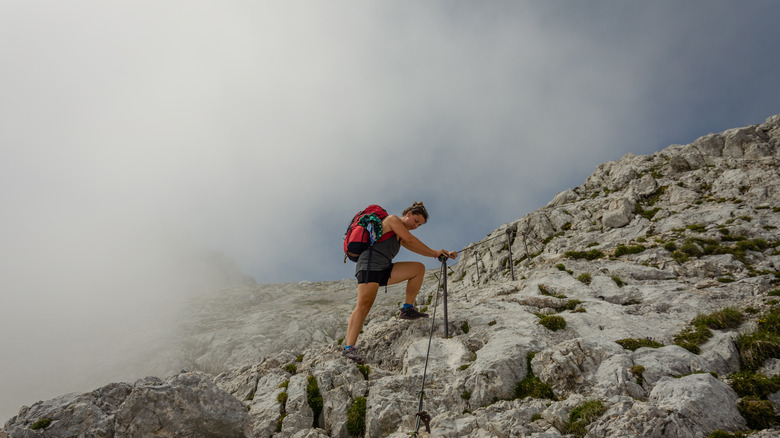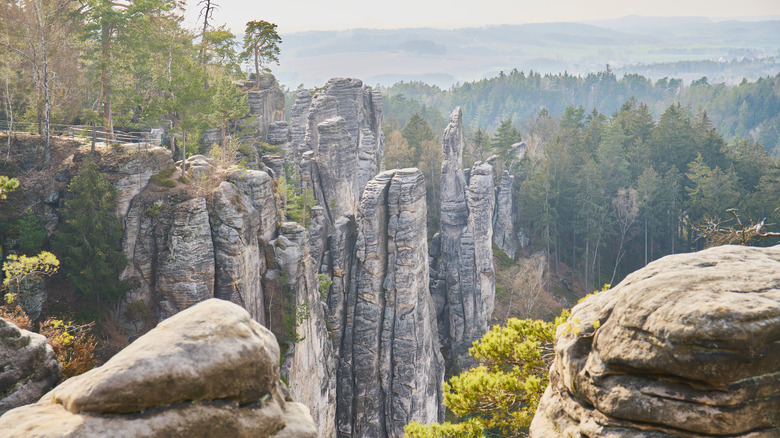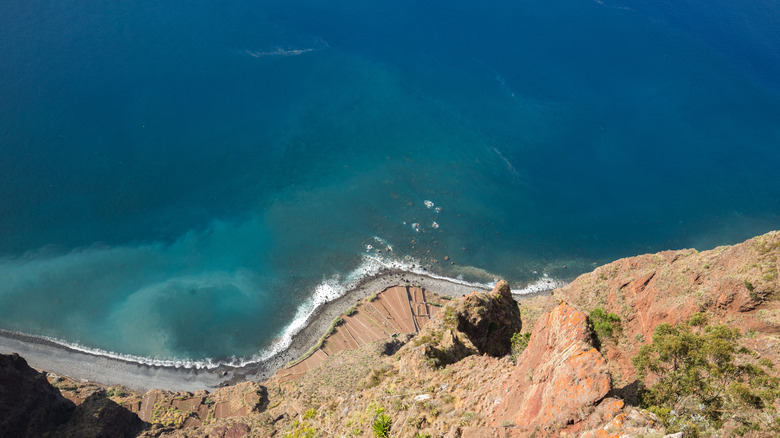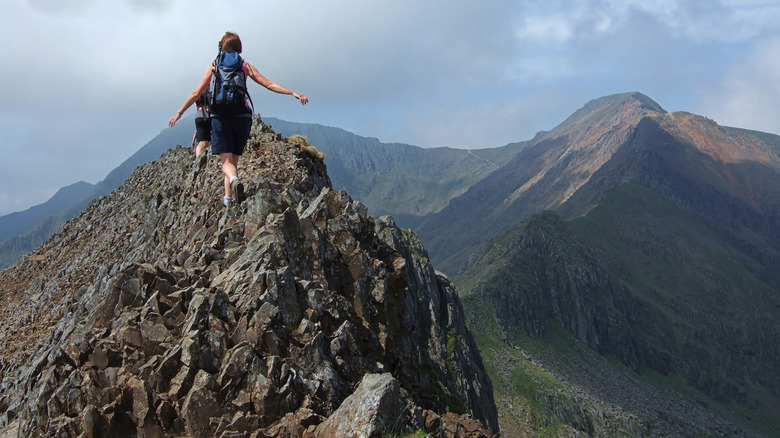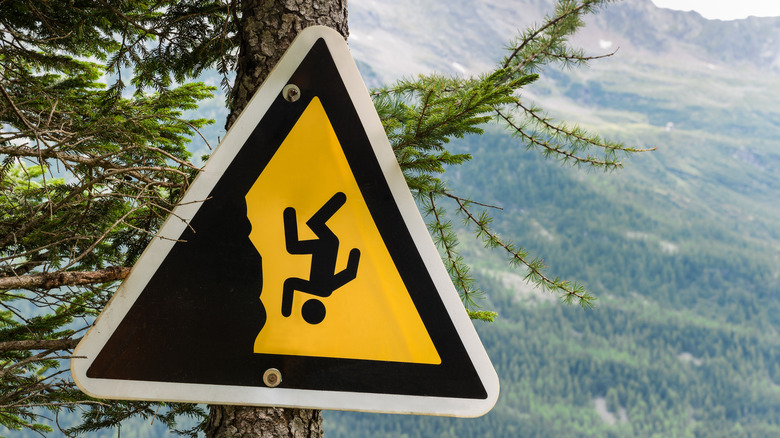Europe's Most Difficult And Dangerous Hikes For Thrill Seekers To Try
With such a diverse landscape and terrain, Europe offers thrill seekers, avid hikers, and wilderness explorers a wealth of incredible hiking opportunities. Many of these phenomenal trekking excursions range from moderate to beyond strenuous — the latter often being dangerous and difficult. But if you are looking to enjoy some of the most scenic spots in Europe and put your outdoorsy skills to the test, then some great adventures lie ahead.
Of course, one's hiking experience level should always be considered before embarking on any infamous trekking route. And proper planning and training are undoubtedly musts here — especially when traversing across various sections of the Alps. That said, much of the covered ground will take travelers to Portugal, Slovakia, and everywhere in between. There are also several bold walkabouts in the U.K. But, regardless of the chosen way forward, daredevils should expect nothing less than remote and truly demanding expeditions. So, if you are up for the challenge, here are Europe's most difficult and dangerous hikes to add to your travel itinerary.
The Dolomites, Italy
A truly stunning mountainous holiday region, the Dolomites, is located in the northern Italian Alps and has hundreds of miles of scenic and thrilling hiking routes. One of the most popular trails for long-distance trekking is the Alta Via 1, a 75-mile tour that reaches an elevation of well over 9,000 feet and can take 10 days or more to complete. Though traversing the Dolomites is not considered particularly difficult due to the length of trails like the Alta Via 1 and the overall current condition of many other routes here, a hike in the Dolomites is indeed dangerous.
Since the Dolomites are a top tourist destination with all-year-round recreation, this enchanting mountain range has seen a fair share of visitors, including mountain bikers, skiers, and hikers. As a result, more than a few trails have become overrun, narrower, steep, and extremely rocky. Some areas are so eroded that hiking in certain regions of the Dolomites is considered to be possibly life-threatening if you are not careful.
Moreover, attempting this trek in colder months or solo can worsen a bad situation. So, to avoid unnecessary risks while adventuring in the Dolomites, plan a hike in the summertime or early fall, and remember it is always better to explore more remote wilderness areas via tour or as part of a group.
El Caminito del Rey, Spain
Previously touted as one of Spain's most dangerous hikes, El Caminito del Rey was once called the "Walkway of Death" — but no pressure. This exciting trek runs along the magnificent Guadalhorce River gorge, just under 5 miles long. El Caminito del Rey is a moderate to challenging walkabout that can be completed in one hour or less. But what makes this particular suspended pathway so treacherous is its slim and sometimes steep boardwalks that hug the sheer rocky curves of the gorge and offer little room for error or a misstep.
Sadly, over the years, several people have lost their lives making their way around this gorge due to disrepair; however, a complete renovation of the boardwalks followed. Now more sturdy, these 100-meter-high (330 feet above the Guadlhorce River) wooden pathways are still relatively narrow. And even though landslides, high winds, and heavy rains have recently been a cause for concern, daredevils can still expect an exhilarating rush when hiking this route, weather permitting.
The surrounding landscape is gorgeous and filled with impressive cliffs, stunning canyons, a pristine valley, and ample wildlife. So, since there is much to see, it is highly recommended that you take your time along El Caminito del Rey for safety reasons and to soak up every moment of this incredible experience.
Aonach Eagach Ridge, Scotland
Located in the breathtaking Scottish Highlands, Aonach Eagach Ridge is one of the more death-defying excursions in Europe. With its rough terrain, knife-edge ridge, and unforgiving return route, the Aonach Eagach Ridge is a tough trek. Not only are some stellar hiking skills required here, but thrill seekers will also need some experience climbing or scrambling, at least if they'd like to get back down this utterly steep pathway safely.
Over 950 meters tall(3,120-plus feet), the Aonach Eagach Ridge is not where you want to lose your footing. Moreover, this natural wonder in Glen Coe has several drop-offs that hikers need to be aware of. That said, the actual ridge is only 6 miles long. However, most daredevils that scale this terrain take eight to nine hours to complete.
Hikers will have two main routes to choose from — the incredibly steep Am Bodach to the summit or from further east along the Allt Ruigh trailway to the top. Either way, the Aonach Eagach Ridge is a serious multi-stage trek not for the faint-hearted that ranks high on the list of European hikes that can quickly turn into a life-or-death situation.
Trift Bridge Hike, Switzerland
Located in the Swiss Alps, high above it all, explorers will find the Trift Bridge. With several possible routes to take here, adventurers can decide how challenging the road ahead will be — trails vary in length, incline, and difficulty level. However, the most common route, from Triftbahn summit station to the bridge and back, is a moderate trek and typically takes most hikers about three hours. Regardless of your desired path, all routes are equally scenic, showcasing the area's untouched beauty, with lakes, lush forested land, glaciers, and, of course, the star of the show, the Trift Bridge.
This pedestrian suspension bridge is considered one of the most dangerous bridges in the world and has been known to claim a few lives. So, thrill seekers can prepare for a truly riveting experience after hiking several miles. At 330 feet, the Trift Bridge is approximately 560 feet long and is not for the timid or anyone with a fear of heights. To access the bridge, hikers must walk up countless steep steps before slowly crossing. Weather conditions play a major role in how treacherous this particular hiking adventure may or may not be, but a certain amount of sure-footedness is required.
Grand Randonnée 20, France
Yet another steep and strenuous endeavor for most hikers is the Grand Randonnée (GR)20 in France. Revered as one of Europe's lengthiest and most difficult long-distance hikes, this 112-mile journey across the French island of Corsica is undoubtedly challenging for even the most experienced hikers. With steep and unyielding terrain, approximately six people are estimated to die on this trek each year. So, thrill seekers should take every precaution when trekking about the GR20.
Open all year round, the GR20 does not require a hiking permit and is best tackled in stages — around 16 or so, to be exact. Hikers, over the course of 11 to 16 days (weather permitting), can opt to go from north to south or south to north along this route. There are more than a few incredible highlights to check out as you make your way through the strenuous Cirque de la Solitude, Lac de Nino, Monte d'Oro, and beyond.
From climbing towering rockfaces with secured chains and trekking through every kind of terrain imaginable to traversing Corsica's 12th-highest summit and then some, the GR20 will put all your outdoorsy skills to the test.
Striding Edge, England
A more manageable hike in Europe is the Striding Edge, located in England's Lake District. This daring walkabout is one of three main routes — Striding Edge, Swirral Edge, and Thirlmere — that allows thrill seekers to check out the summit of Helvellyn in all its glory. Standing approximately 3,118 feet tall, Helyellyn is Lake District's third-highest mountain, so hikers can expect a truly adrenaline-pumping experience here.
Most mountaineers can complete this fantastic adventure via the Striding Edge loop in roughly five hours during the warmer months. This same trail, however, will take you seven to eight hours in the winter. Still, the snow-blanketed views during the colder months are simply spectacular, so what is an extra hour or two?
Of course, no matter the season, Striding Edge is a challenging 8-mile hike. Due to narrow exposed pathways, steep sections, some required scrambling, and temperamental weather conditions, including frequent strong crosswinds, Striding Edge should be approached with the utmost care. With rocky terrain around every corner, this trek can quickly become dangerous and has, in the past, even been deadly. For daredevils who have a change of heart at the last minute, a slightly less terrifying path is nearby that offers the same exciting and gorgeous vistas.
Eagle Walk, Austria
The Eagle Walk trek in Austria is another European mountain adventure that will test your hiking prowess. Running the entire length of Tyrol, the Eagle Walk is a multi-day excursion typically done in 33 stages (24 in North Tyrol and nine in East Tyrol). With well-marked footpaths, diverse landscapes, numerous routes, and many scenic highlights, hikers can decide how much of the Eagle Walk they want to tackle if they are not up for the entire 257-mile long-distance trek.
Thrill seekers need to understand basic alpine techniques, be prepared for moderately tricky to difficult trekking regardless of their goals, plan out their intended route well in advance, and be comfortable hiking to higher than high heights. Likewise, daring Eagle Walk hikers should be in peak physical condition, as they will be traversing through several mountain ranges. And even though this walkabout is not inherently dangerous if you meet all the qualifications above, if you have any doubts about trekking the Eagle Walk, remember it is better to be safe than sorry.
Mount Triglav, Slovenia
Located in Slovenia, Mount Triglav has quite a reputation. Part of the rugged Julian Alps, Mount Triglav is 2,864 meters tall (9,397 feet) and is the highest point in Slovenia. With many routes available, making your way up to this natural wonder is no small feat — most mountaineers opt for a one-day or two-day hike, though this trek can be completed in 11.5 hours if desired. Things tend to get a little tricky here with the very narrow 14-mile-long gravel or sheer rock footpaths and the clear need for first-rate climbing skills.
Yet, not everyone packs climbing gear for this labor-intensive trek, instantly taking an otherwise challenging hike from exhilarating to high-risk. The few daredevils that try to wing it sans the necessary equipment are left free-climbing boulders and pulling themselves up twisting metal ladders. What's more, even when one is not scrambling about, these slippery footpaths are littered with drop-offs and leave practically no room for error. And with the highest number of mountain-related deaths and accidents in Sloveni, Mount Triglav is serious business any way you look at it, so take all the necessary precautions here and do not forget your climbing gear.
Bohemian Paradise, Czech Republic
Though the Bohemian Paradise in the Czech Republic is relatively safe, there are still some areas along the way that could be potentially harmful if you lack the necessary hiking essentials, attempt to go exploring during the winter season, or test your luck in poor weather conditions. Still, a moderate to challenging trek awaits thrill seekers in Bohemian Paradise, the Czech Republic's oldest nature reserve. Offering a healthy mix of trails, embarking on your own customized ethereal adventure in the Bohemian Paradise is not hard to do. However, guided excursions are available as an alternative, too.
In general, Bohemian Paradise explorers can expect to traverse ancient cities made of sandstone and marvel at this region's lush forested land. One of the most popular routes to take here during the summer and fall is from Turnover to Hrubá Skála. This one-way six-plus-mile trek takes you through the steep mountain ranges, offering splendid views of the surrounding arboretum, castle ruins, towering rock formations, and more.
Hikers can extend this scenic journey further into the wilderness for an over five-hour walkabout. And if you are looking for extra excitement, climbing or scrambling the sandstone rock formations is also permitted — though this is ill-advised in wintery weather or if it has rained in the last few days.
Faja dos Padres, Madeira
Located in Madeira, the Faja dos Padres trail offers nature explorers incredible seaside vistas. But with narrow footpaths, crumbling coastal cliffs, wild terrain, and extreme drop-offs, this scenic hike is challenging and undoubtedly a risky venture. Even for the most skilled hiker, navigating unstable ground, avoiding overgrown cacti, and safely crossing more than a few waterfalls make this under-4-mile trek dangerous.
When using extreme caution, however, adventurers (via a guided hike) can usually complete the Faja dos Padres trail in a few hours. In addition to being extra careful, thrill seekers should watch out for altitude sickness as this trek's incline is over 580 meters (1,900-plus feet). And with falls being the most common of accidents on this trail, the further you go, the more you need to pay attention to the task.
Overall, the stakes are high on the Faja dos Padres trail, so preparing for the unexpected here is important. It is also worth noting that this difficult hike should not be attempted without a guide or a fair amount of hiking experience.
Crib Goch, Wales
Last but not least, Crib Goch, located in Snowdonia National Park in Wales, is a trek avid hikers will never forget. Thanks to this knife-edge ridge's rugged terrain, this is undoubtedly a harder-than-average trek for your typical national park explorer. Hikers must have the adequate scrambling experience to complete this once-in-a-lifetime excursion with its exposed trails and questionable footpaths.
Moreover, this six-mile-long trek will have you teetering at 3,100-plus feet. Thus, having solid footing is a must here. Usually completed in about five hours, Crib Goch rewards the bold with gorgeous mountain vistas as far as the eye can see. Still, Crib Goch is not a hike to underestimate, as it is considered by many to be the most dangerous hiking tour one could attempt in Wales. So daredevils should proceed cautiously — especially during the colder months or in the face of high winds. That said, Crib Goch or any of the exhilarating European treks recommended above should fulfill one's need for a death-defying adventure.
Hiking hazards
Attempting to complete challenging hikes anywhere in the world is impressive. But what takes a challenging trek to the next level? For most thrill seekers, a truly difficult trail is off-beaten, wild, and just strenuous enough without losing that adventurous quality. However, unexpected situations and conditions often turn an otherwise harmless adrenaline-pumping adventure into something a lot more dangerous.
Depending on your location and the season, a few hazards to be mindful of when embarking on a dangerous walkabout include the likelihood of avalanches, icy pathways, flash flooding, heavy rains, unstable terrain, and sudden weather changes. Likewise, getting lost, dehydrated, falling, altitude sickness, and not having the right gear handy are all real concerns, no matter how skilled a hiker you are. Still, mitigating many of these hazards is possible with proper planning, continuous checking of the weather, and preparing for your intended destination's commonly experienced risks.

